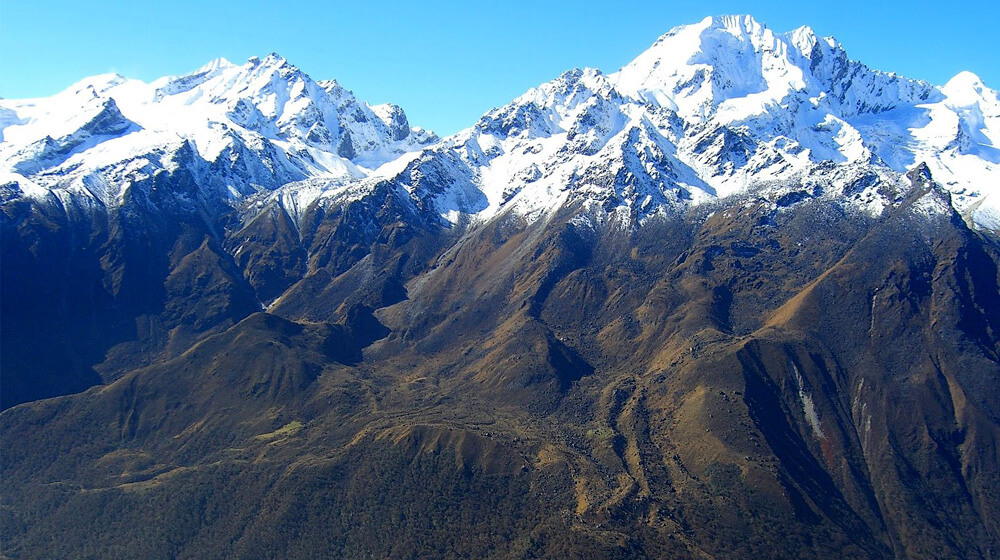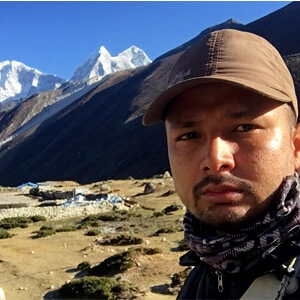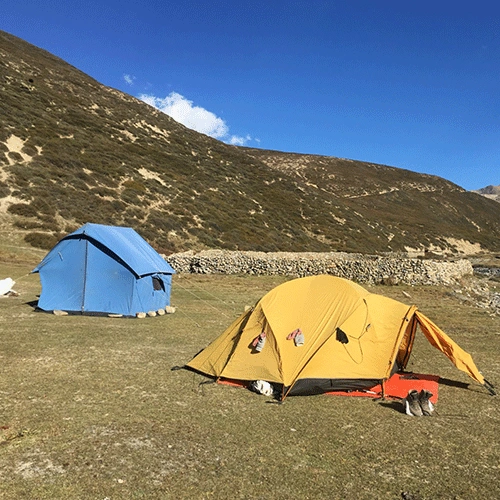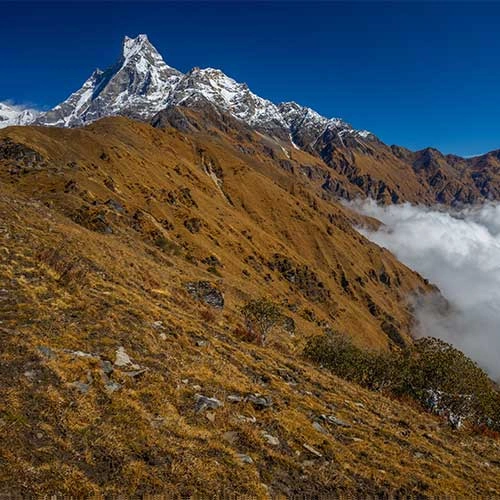Top Reason to Go Langtang Gosaikunda Trek
The Langtang and Gosaikunda trek is a well know trekking area of Nepal. This route is very beautiful and peaceful and is in the north of Kathmandu valley. Just 51 kilometers from the capital, the Langtang region is very famous for adventure treks. Having one of the very sacred lakes (one of the holy destinations for Hindu people), this National Park is also famous for its varied vegetation and wildlife.
The majestic view of the Langtang Himalayan range including mountains such as Langtang Lirung (7227 m), Langsisa Ri (6427 m), Langtang Ri (7,205 m), Yala Peak (5520 m) is just a breathtaking experience.
After the devastating earthquake that hit Nepal in 2015, old houses were destroyed, and new ones started to get built. Passing through villages, Syabrubesi, New Bridge, Bamboo, Rimche, Lama Hotel, Ghoda Tabela, and Langtang village along our way, we spend our night in tea houses. These tea houses are comfortable enough to provide us with a good night’s rest.
The wildlife and vegetation along the trail are sure to win our hearts. Langtang region hosts a variety of climatic regions from subtropical to the alpine regions. It contains forests of oaks, maples, pine, and rhododendrons.
The maximum altitude of this trek is 5000 meters at Tserko, a hill station which is located above Kyanjin Gompa. Tserko is one of the best vantage points for the stunning view of mountains and landscape. All these beautiful memories and amazing experiences make Mountain adventure unforgettable.
Here is the major highlight of the Langtang Gosaikunda trek. Read through to know more about the trek.
Major Attractions of Langtang Gosaikunda Trek
Langtang National Park
Langtang National Park is one of the key highlights of our Langtang Gosaikunda trek. This national park is the shelter for several flora and fauna. It is mainly famous for its rich and pristine forest. Many wild animals and vegetation can be found here. Red pandas, snow leopards, Himalayan Black bears, Himalayan Tahr, yaks, and so on can be found here, and they add to the pre-existing beauty of the place. Also, more than 200 species of birds have been recorded in the national park. This includes Himalayan Monal, Satyr Tragopan, Ibisbil, red-headed vulture, and so on. Langtang national park provides us with a great opportunity to wander into nature in its rawest form along with its wildlife and lush vegetation.
The Langtang National Park has a wonderful landscape and there are several trekking routes. Some major trek names are as:
Additional Information:
- It requires a permit to enter the National Park and to obtain a TIMS card to trek in the Langtang Gosaikunda trek.
- These Permits and TIMS cards can be obtained from Nepal Tourism Board Office on Pradarshani Marg, Kathmandu.
Kanjin Ri (4328 m)

Kyanjin Ri is one of the best viewpoints during our whole Langtang region trek. It provides us with a great opportunity to enjoy the 360 degrees view of the Langtang range. Sunrise from Kyanji Ri is something we will be sure not to miss during our trek. Though it is a difficult climb to the top of the hill, the rewards are equally, if not more, amazing. Breathtaking views of tall and majestic Langtang Lirung, Changbu, Yuba, Naya Kanga, and Yala peak can be enjoyed from atop. The trek to Kyanjin Ri starts from the beautiful village of Kyanjin Gompa, which is another key highlight of our Langtang trek.
Gosaikunda Lake

Gosaikunda is a very sacred lake and holds a very high religious value to the Hindus. Located at an elevation of 4380 meters, this lake lies in Langtang National Park in the Langtang region. There is a total of 108 lakes in the vicinity. Frozen for 6 months from October to June, the Gosaikunda lake complex comprises 4.0 square miles. The trek to Gosaikunda lake offers a beautiful view of the lap of mountains and melts to form the Trishuli river. Every trekker is sure to be amazed upon their first glance at Gosaikunda lake.
Reason Why go for Langtang and Gosaikunda Trek
Walking in the lap of nature has its perks and enjoying the amazing mountains in the Langtang region is one of them. Throughout this trek, we are accompanied by beautiful and tall mountains. Langtang Lirung is the tallest in the range, dominating the skyline. From Kyangjin Gompa, we can see the glaciers up close along with the snow-capped mountains. Experienced trekkers can also attempt to climb two famous peaks of Yala (5500 m) and Naya Kanga (5846 m). The latter requires a permit to climb.
Choice of Camping or Staying in Tea Houses
Another major good point or advantage of the Langtang Gosaikunda trek is that we have options regarding our accommodation. We can either choose to stay in tea houses or we can also enjoy trekking in its raw form i.e., camping. Kyangjin Gompa is the last inhabited village in the region at an elevation of 3800 meters.
Further up there are no more tea houses and you need to do camping. But there are plenty of tea houses still there to provide us with a comfortable resting place. Some places provide better accommodation than others. Nevertheless, the accommodations are sound and comfortable, allowing us to completely enjoy our trek.
Fewer Crowds of People
One of the major reasons for us being able to enjoy the Langtang region is the peace and calm it brings to us. In a crowdy place, it is not possible to enjoy those things. Lucky for us, the Langtang region is a less trekked route.
After the earthquake that hit Nepal in 2015, tourism dropped quickly in this region. But due to the effort of the Government and natives, this place is soon recovering. Trekkers have started coming back to this route, but their numbers are still low enough to let us enjoy our trek in peace.
Local People and Their Warm Hospitality
Being a less traveled trekking route, the Langtang region has very welcoming and friendly natives. These people teach the real way guests are supposed to be treated. Their culture resembles the Buddhist Tibetan culture. Typical Sherpa and Tamang traditions surely will amaze us. We can also get a very insightful look into their culture and traditions. What is a journey without its own folk tales? Be sure to know the region’s interesting stories.
Wildlife and Vegetation
The Langtang Gosaikunda trek provides a very peculiar type of wildlife and vegetation. Its wildlife includes animals like red pandas, snow leopards, Himalayan Black bears, Himalayan Tahr, yaks, and so on. There are also many different species of birds, which can be encountered during our trek. These animals are hosted by Langtang National Park and many forests. These include forests of oaks, pines, maple, rhododendron, and so on. Along with the view of majestic mountains in front of us, trekking through these forests is icing on the cake.
Best Seasons for Langtang Gosaikunda Trek
December – February
The best time for trekking the Langtang region is during the month of February. Three months of December, January, and February consist of cold weather and clear skies. Fewer trekkers are trekking during this time of the year. The views are also very clear and open to let us enjoy the scene to its fullest.
March-May
The months of March, April, and May have moderate climates with beautiful blooming rhododendron. There are more than 30 species of rhododendron in Langtang’s trail. And in bloom, these all look amazingly beautiful.
June – August
The months of June, July, and August fall during the monsoon season. The trail becomes slippery and difficult, so trekkers are not advised to trek during this season.
September – November
During the months of September, October, and November, the view is very clear and beautiful. Clearer skies along with beautiful waterfalls and flowers make for an amazing landscape. This is the second-best season to enjoy the Langtang region trekking.






